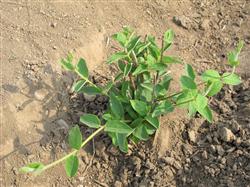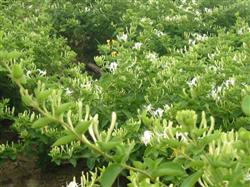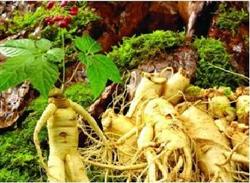Seedling raising and High-yield measures of Honeysuckle cuttings

Flower buds, flowers, leaves can be used as medicine, heat, anti-inflammatory; rattan medicinal, treatment of rheumatic bone pain; flowers can extract aromatic oil, and extract honeysuckle dew; but also landscaping, garden cultivation ornamental tree species. First, honeysuckle cutting seedlings honeysuckle can be used for seed propagation, but also for cutting and root propagation, but seed propagation growth is slow, the income is late, the root propagation coefficient is low, so the production is currently using rod insertion propagation, propagation materials, high survival rate, fast income. Specific practices are divided into direct cuttage and seedling cuttage two. direct cutting, adopting the big hairy flower variety with developed root system and strong branch germination in mountainous area, selecting strong and vigorous 1-2 year old branches without diseases and insect pests to cut into 30- 35cm long in summer and autumn rainy season, picking the lower leaves for cutting, cutting and inserting directly in the hillside terrace, weir and other gaps, digging holes with diameter of 25- 30cm according to the plant spacing of 1.3- 1.7m, hole depth of 16- 18cm, inserting 4-6 cuttings into each hole, dispersing the cuttings into inclined holes, 5-10 cm exposed on the ground, after insertion fill compaction, in case of drought, appropriate watering to improve survival rate. In order to save branches and facilitate management, young cuttings are often used. The method is to select plots that are convenient for watering, deep ploughing and leveling, apply appropriate amount of soil fertilizer as base fertilizer, and in July and August, according to the row spacing of 23-26 cm, the depth of about 16 cm, the cuttings are placed obliquely in the ditch according to the plant spacing of 2 cm, and then the cuttings are filled and compacted. After planting watering, if the weather is dry, watering once every 2-3 days, keep the soil moist, half a month left heart can take root and germinate, the second year fragrant season or autumn transplanting. Second, honeysuckle shaping pruning is an important measure to improve the yield of natural growth of honeysuckle, branches are very long, must set up a stent or shaping pruning, such as put aside, branches creeping on the ground overlap each other, then the flowering amount is small, the yield is very low, so set up a stent and shaping pruning is the key to improve honeysuckle yield. in particular, prune has a remarkable effect on that yield increase of honeysuckle. according to the experiment in Pingyi County, Shandong province in 1983, aft one winter pruning and three pruning in growth period, the average total yield of flowers per stump is 969 g, while that of unpruned flowers is 685 g. the yield of pruned flowers per stump is 284 g higher than that of unpruned flowers, or 42%. After pruning, the utilization rate of light energy of each part of flower pier is improved, ineffective branches and leaves such as weak branches and excessive branches are removed, the consumption of nutrients and water is reduced, the branches and leaves are most reasonable, the growth environment is improved, and the branches and plants are healthy, which is beneficial to high yield of honeysuckle. The specific method is: the honeysuckle cultivated for one or two years, before the branches sprout in spring, cut off the upper part, leaving only about 33 cm as the trunk, after several years of continuous pruning, the trunk is thick, it can stand upright into a pier, and the branches at all levels on the trunk form an umbrella-shaped dome, which not only provides ventilation and light, increases the number of flowers, but also facilitates the collection of buds. Honeysuckle has strong natural regeneration ability, many new branches, although the flowering branches can continue to grow that year, but not in flowering, only in the original flowering mother plant germination of new shoots, can reproduce buds. Honeysuckle pruning must be determined according to the variety, pier age and branch type. According to the experience of Linyi area in Shandong Province, the creeping large hairy flowers with crown width of 120-140 cm and the presbyopic piers with long branches should be cut again. Cut long branches, thin short branches, cut thin and equal. Strong flower pier, mainly light shear, less sparse long stay, young flower pier to cut mainly, promote branching, accelerate the expansion of pier crown. Three-dimensional chicken claw flower, trunk obvious, branches do not touch the ground, crown width 80-12O cm, pruning should be done to the top, clear foot cluster, hit the bore, pruning long branches, sick branches, dead branches, downward extension branches, so that branches into clusters upright, trunk thick, branches dense evenly, flower pier into umbrella shape, good ventilation and light transmission, so that new branches more, buds more. The pruning time is winter pruning, which can be carried out from December to late February of the following year. The other is cutting in growth period, which is carried out after each flower picking, in order to promote the formation of multiple crops of flowers and improve yield. The first spring shoot cutting after the first crop was carried out in early June, the second summer shoot cutting after the second crop was carried out in late July, and the third autumn shoot cutting after the third crop was carried out in early September. Growing season pruning, requirements to light shear mainly. 3. Common stem borers and their control 1. The damage rate of flower stumps over ten years in Pingyi and Fei County, Shandong Province, which are the old producing areas of coffee tiger beetle honeysuckle, is 80%. After being killed, the vitality is weak. After being killed for several years, the whole plant dies. One generation occurs in Shandong every year. The newly hatched larvae eat ants on the xylem surface first. When the larvae reach 3 mm, they eat longitudinally to the xylem, forming tortuous channels. The holes are full of sawdust and insect dung, which are very hard. There are no dung holes on the surface of branches, so it is difficult to find them. At this time, chemical control is not effective. Control methods: ① Spraying 80% dichlorvos emulsion 1000 times solution in April and May at adult stage and larva initial hatching stage has certain effect on controlling adults and larvae. (2) In July and August, when the temperature is above 25℃, the release of Scleroderma longipes in the field has good control effect. 2. Leopard wood moth occurs one generation a year in Shandong Province. After hatching, the larvae will eat people from branches or new shoots. After 3-5 days, the new shoots will wither. After the larvae grow to 3-5 mm, they will discharge insect dung from the holes of the people. It is easy to find and has the habit of turning plants to harm. Larvae bite a circle between xylem and phloem, so that branches are easy to break in case of wind, one side of the injured branch often has several dung holes, insect dung is cylindrical, pale yellow, 9-10 months flower pier appears dead branches. Control methods: ① Clean the flower pier in time. After harvesting the second crop of flowers, pruning must be combined from late July to early August. Cut off the branches with insects. If pruning is too late, cut off the branches when the larvae bite into the lower thick branches, which will affect the growth potential of the flower pier. (2) The middle and late July is the peak incubation period of larvae, which is the suitable period for pesticide control. 40% omethoate EC 1500 times solution added with 0.3%-0.5% kerosene can promote the penetration of the solution into the stem, and good control effect can be obtained. 3. A new generation occurs every two years in Shandong Province, spanning three years.
- Prev

Propagation and High-yield cultivation techniques of Flos Lonicerae
Honeysuckle (lonicerajaponicathunb), alias honeysuckle, Erhua, honeysuckle or mandarin duck vine, is a semi-evergreen twining vine of Lonicera, with young branches densely covered with coarse hairs and glandular hairs, leaves opposite, ovate or ovate-lanceolate, 3-50n long, entire, coarsely hairy on both sides when young. Flowers in pairs in leaf axils, Corolla tubular,.
- Next

Field-to-home cultivation techniques of bamboo ginseng
(1) Cuttage is generally used for propagation. Cuttings with 5-7 leaves and about 15 cm of mature branches are cut into the sand bed. The row spacing is 4 cm × 10 cm. Keep the sand bed moist and grow roots for transplanting in about 20 days. It can be cut all year round, and it is easy to take root in spring and autumn. It is appropriate to choose a shady area as a seedbed in summer.
Related
- Fuxing push coffee new agricultural production and marketing class: lack of small-scale processing plants
- Jujube rice field leisure farm deep ploughing Yilan for five years to create a space for organic food and play
- Nongyu Farm-A trial of organic papaya for brave women with advanced technology
- Four points for attention in the prevention and control of diseases and insect pests of edible fungi
- How to add nutrient solution to Edible Fungi
- Is there any good way to control edible fungus mites?
- Open Inoculation Technology of Edible Fungi
- Is there any clever way to use fertilizer for edible fungus in winter?
- What agents are used to kill the pathogens of edible fungi in the mushroom shed?
- Rapid drying of Edible Fungi

